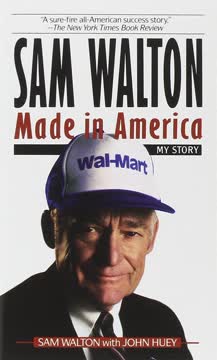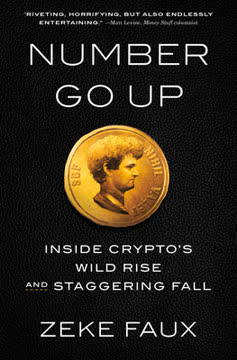Key Takeaways
1. Walmart's Missed E-Commerce Opportunity in the Late 90s
“I’ll take it to my grave how big of a mistake it was and how impactful it would have been to retail if we had done what I was advocating.”
Robert Davis's Vision. In the late 1990s, Walmart executive Robert Davis recognized the immense potential of e-commerce and urged CEO David Glass to invest heavily in online retail. Davis believed that Walmart's existing infrastructure, resources, and product range could easily outcompete the then-nascent Amazon.
Betting the Badge. Davis proposed a high-stakes bet, offering to resign if his plan failed, but Glass declined, predicting that Walmart's online store would never surpass the sales of a single Sam's Club location. This decision proved to be a critical turning point, allowing Amazon to gain a significant head start in the e-commerce market.
Consequences of Inaction. Davis's departure and Walmart's initial reluctance to fully embrace e-commerce allowed Amazon to establish itself as the dominant player in the online retail space. This missed opportunity would haunt Walmart for years to come, forcing them to play catch-up in a rapidly evolving market.
2. Amazon's Ruthless Pricing Strategies and Walmart's Response
“Our marketing strategy is our pricing strategy.”
Price Wars. Amazon, inspired by Walmart's "everyday low prices," adopted aggressive pricing strategies to gain market share. They even experimented with charging different customers different prices for the same products, a move that backfired and damaged customer trust.
Competitive Monitoring. Amazon developed sophisticated pricing tools to track and match or beat competitors' prices, including Walmart's. This allowed them to undercut Walmart and attract price-conscious customers.
Walmart's Internal Conflicts. Walmart struggled to respond effectively due to internal conflicts between its e-commerce and store divisions. Store leaders feared that lower online prices would cannibalize in-store sales, hindering their ability to compete with Amazon.
3. The Jet.com Acquisition: A Bold Move for Walmart
“The whole thesis was it would make us faster.”
Marc Lore's Vision. Marc Lore, the founder of Diapers.com and Jet.com, emerged as a key figure in Walmart's e-commerce strategy. His vision for Jet.com, which focused on offering the lowest prices on the web through a unique discounting structure, caught the attention of Walmart CEO Doug McMillon.
Acquisition and Integration. In 2016, Walmart acquired Jet.com for $3.3 billion, bringing Lore on board to lead its US e-commerce operations. This move signaled Walmart's commitment to taking on Amazon and injected new energy and talent into its digital efforts.
Cultural Clash. The acquisition also brought a clash of cultures, as Lore's startup mentality and aggressive growth strategies clashed with Walmart's traditional, cost-conscious approach. This tension would play out in various ways, shaping the company's e-commerce strategy in the years that followed.
4. Doug McMillon's Transformation of Walmart's Culture
“We needed a forty-something CEO with a tech bias because Mike wasn’t the right guy for where we needed to go.”
A New Kind of Leader. Doug McMillon, who became Walmart's CEO in 2014, represented a shift in leadership style and priorities. He recognized the need to modernize the company and embrace digital innovation to compete with Amazon.
Embracing Change. McMillon actively sought to transform Walmart's culture, encouraging experimentation, empowering small teams, and fostering a more customer-centric approach. He also made efforts to improve employee wages and benefits, signaling a commitment to social responsibility.
Balancing Act. McMillon faced the challenge of balancing the need to invest in e-commerce with the need to maintain the profitability of Walmart's core store business. This required navigating internal conflicts and making difficult decisions about resource allocation.
5. Amazon Prime: A Game-Changer Walmart Struggled to Counter
“We want Prime to be such a good value, you’d be irresponsible not to be a member.”
Prime's Dominance. Amazon Prime, with its combination of free shipping, streaming services, and other perks, became a powerful force in the retail landscape. It created a loyal customer base and incentivized frequent purchases on Amazon.
Walmart's Response. Walmart initially struggled to counter Prime, launching a less compelling membership program called ShippingPass. This program lacked the breadth of benefits and the brand recognition of Prime, failing to attract a significant number of customers.
Walmart+ Emerges. Eventually, Walmart launched Walmart+, a revamped membership program that offered free shipping, discounts on gas, and other perks. While Walmart+ has gained some traction, it still lags far behind Amazon Prime in terms of membership numbers and overall impact.
6. The Battle for Online Grocery: Walmart's Store Advantage
“All they had to do was exploit that.”
Walmart's Strength. Walmart possessed a significant advantage over Amazon in the online grocery market: its vast network of physical stores. These stores could serve as distribution points for online orders, enabling faster delivery and lower shipping costs.
Early Missteps. However, Walmart initially struggled to leverage its store network effectively. Internal conflicts and logistical challenges hindered its ability to offer a seamless online grocery experience.
Grocery Pickup and Delivery. Over time, Walmart made progress in expanding its online grocery pickup and delivery services. These offerings have become increasingly popular, providing a convenient alternative to traditional grocery shopping and helping Walmart compete with Amazon in this crucial category.
7. The Clash of Cultures: Old School vs. New School at Walmart
“You have to sink a serious amount of marketing money in if you’re going to steal customers away from someone else. And if you have a membership model, it gets even worse.”
Traditional vs. Digital. The integration of Jet.com and its leadership team into Walmart's existing structure created a clash of cultures. Lore's data-driven, growth-focused approach often clashed with Walmart's traditional, cost-conscious mindset.
Conflicting Priorities. This cultural divide manifested in various ways, from disagreements over marketing spending to differing views on the importance of profitability. It also led to tensions between the e-commerce and store divisions, hindering collaboration and innovation.
McMillon's Challenge. McMillon faced the challenge of bridging this cultural gap and creating a unified vision for Walmart's future. This required navigating competing priorities, managing egos, and fostering a sense of shared purpose across the organization.
8. Amazon's Health Care Ambitions and Walmart's Response
“We’ve got to get the hospitals and doctors in line. We’ve got to get those charges under control."
Amazon's Entry. Amazon's acquisition of PillPack signaled its intent to disrupt the $350 billion prescription drug market. This move posed a direct threat to Walmart, which had a significant presence in the pharmacy space.
Walmart's Health Initiatives. Walmart responded by expanding its own health care offerings, including opening Walmart Health centers that provide primary care, dental, and other services. These centers aimed to provide affordable and accessible health care to underserved communities.
The Future of Health Care. Both Amazon and Walmart are vying to become major players in the health care industry. Their efforts could potentially transform the way Americans access and pay for medical services, but significant challenges remain.
9. The Pandemic's Impact: Accelerating E-Commerce and Exposing Weaknesses
“The only thing that gets you aligned is when a new competitor like an Amazon . . . pop[s] up and you realize, ‘Holy smokes, this thing is legitimately for real.’”
E-Commerce Boom. The COVID-19 pandemic accelerated the shift to online shopping, benefiting both Amazon and Walmart. However, it also exposed weaknesses in their supply chains and fulfillment capabilities.
Supply Chain Challenges. Both companies struggled to keep up with surging demand, leading to delivery delays and product shortages. This highlighted the importance of building resilient and flexible supply chains.
Worker Safety. The pandemic also raised concerns about worker safety in warehouses and stores. Both Amazon and Walmart faced criticism for their handling of COVID-19 outbreaks and their efforts to protect employees.
10. The Future of Retail: Hybrid Models and the Fight for Customer Loyalty
“If this is a nine-inning game, we’re somewhere in the top of the second. We’re just really still getting started.”
Omnichannel is Key. The future of retail will likely be a hybrid model that combines the convenience of online shopping with the experience of physical stores. Both Amazon and Walmart are investing in strategies to create seamless omnichannel experiences for their customers.
Customer Loyalty. In this competitive landscape, customer loyalty will be more important than ever. Retailers will need to offer compelling value propositions, personalized experiences, and exceptional service to retain customers and attract new ones.
The Long Game. The battle between Amazon and Walmart is far from over. Both companies will continue to evolve and adapt to changing consumer preferences and technological advancements. The ultimate winner will be the one that can best meet the needs of its customers and create a sustainable business model for the future.
Last updated:
Review Summary
Winner Sells All is praised for its in-depth reporting on the rivalry between Amazon and Walmart. Readers appreciate the insider stories and historical context provided. Many find it informative and well-researched, though some criticize its repetitiveness and nonlinear structure. The book offers insights into both companies' strategies, successes, and failures in e-commerce. While some readers express concerns about the negative impacts of these retail giants, others enjoy the business insights. Overall, the book is recommended for those interested in retail, e-commerce, and business strategy.
Similar Books










Download PDF
Download EPUB
.epub digital book format is ideal for reading ebooks on phones, tablets, and e-readers.




